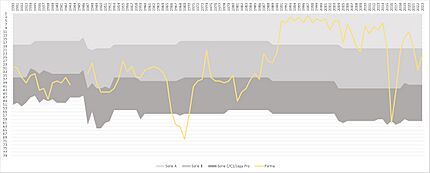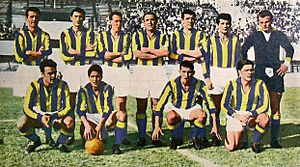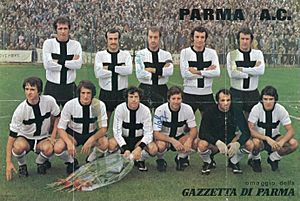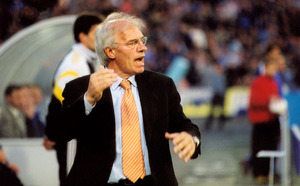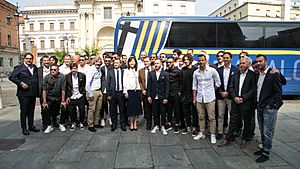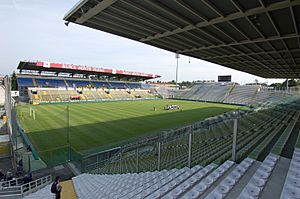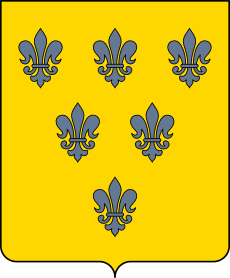Parma Calcio 1913 facts for kids
 |
|||
| Full name | Parma Calcio 1913 S.r.l. | ||
|---|---|---|---|
| Nickname(s) | I Crociati (The Crusaders) I Gialloblu (The Yellow and Blues) I Ducali (The Duchy Men) Gli Emiliani (The Emilians) |
||
| Founded | 27 July 1913 as Verdi Foot Ball Club 27 July 2015 as Parma Calcio 1913 |
||
| Stadium | Stadio Ennio Tardini | ||
| Stadium capacity |
27,906 | ||
| Owner | Krause Group CSR | ||
| President | Kyle Krause | ||
| Head coach | Carlos Cuesta | ||
| League | Serie A | ||
| 2018–19 | Serie A, 14th of 20 | ||
|
|||
Parma Calcio 1913 is an Italian professional football club. It is based in the city of Parma, in the Emilia-Romagna region of Italy. The team plays in Serie A, which is the top football league in Italy. They earned promotion to Serie A in the 2023–24 season.
The club was first started in December 1913. The current club was re-founded in 2015. Parma plays its home games at the Stadio Ennio Tardini. This stadium, often called Il Tardini, has 27,906 seats. The team has played there since 1923.
Parma won eight major trophies between 1992 and 2002. This was a very successful time for the club. They finished second in the league in the 1996–97 season. This was their best league finish ever. The club has won three Coppa Italia cups. They also won one Supercoppa Italiana, two UEFA Cups, one European Super Cup, and one UEFA Cup Winners' Cup.
The club faced financial problems in late 2003. This was due to the Parmalat scandal. The club went bankrupt in 2015. It was then re-founded and started playing in Serie D, a lower league. However, Parma made history by getting promoted three times in a row. This brought them back to the top league in 2018.
Contents
Club History: Parma's Journey
Early Days and Challenges (1913–1968)
The club began in July 1913 as Verdi Foot Ball Club. It was named to honor the famous opera composer Giuseppe Verdi. He was born in the province of Parma. The team chose yellow and blue as its first colors.
In December 1913, Parma Foot Ball Club was formed. Many players from the original club joined. They started wearing white shirts with a black cross. Parma began playing in leagues after World War I in the 1919–20 season. The Stadio Ennio Tardini began construction two years later.
Parma became a founding member of Serie B in 1929. They stayed there for three years before being relegated. The club changed its name to Associazione Sportiva Parma in 1930. They became a founding member of Serie C in 1935. Parma was promoted back to Serie B in 1943. Italian football then stopped because of Second World War.
After the war, Parma spent three years in Serie B. They were relegated to Serie C in 1949. The team spent five more seasons in Serie C. Then they had an eleven-year period in Serie B. They reached ninth place in 1955, a club record at the time. Parma played in European competition for the first time in 1960–61. They won against Swiss team AC Bellinzona in the Coppa delle Alpi. But they were relegated to Serie C in 1965. A year later, they were relegated again to Serie D.
New Beginnings and Growth (1968–1989)
The club faced big problems and was ordered to close in 1968. It changed its name to Parma Football Club that year. In 1969, another local team, Associazione Calcio Parmense, was promoted to Serie D. On January 1, 1970, A.C. Parmense took over the old club's identity. This meant they could use the Crociata shirts, the badge, and the city's name.
This brought better luck for the club. They won the Serie D championship. They spent three years in Serie C before being promoted to Serie B. However, they were relegated back to Serie C after only two seasons. They did not return to Serie B until the late 1970s. Again, they only stayed for one season.
Under manager Cesare Maldini, Parma returned to Serie B in 1984. They won their division on the last day. But they only stayed in Serie B for one year. Arrigo Sacchi helped the club return to Serie B in 1986. That season, the team almost reached Italy's top league. They also beat A.C. Milan in the Coppa Italia. This result convinced Milan's owner to hire Sacchi. Sacchi's replacement, Zdeněk Zeman, was fired quickly. Giampieri Vitali took over and led the team to two mid-table finishes.
Golden Era and Financial Struggles (1989–2004)
Nevio Scala became the head coach in 1989. Scala led Parma to a historic promotion to Serie A in 1990. They won a key game against Reggiana. Money from their parent company, Parmalat, helped the team improve. The club played in UEFA competitions for the first time in 1991.
Scala led the club to its first four major trophies. The first was the Coppa Italia in 1991–92. They beat Juventus over two games. The next year, they won their first international trophy. They beat Belgian team Antwerp 3–1 in the Cup Winners' Cup at Wembley. The next season, they won the European Super Cup. They beat Milan 2–1. But they lost the Cup Winners' Cup final to Arsenal.
Scala's last success was in another final against Juventus. Parma won the UEFA Cup 2–1. But Juventus got revenge in the Coppa Italia final. Scala left in 1996 and was a very popular coach.
Carlo Ancelotti took over and led the team to a record second place in 1997. Parma then played in the UEFA Champions League. Alberto Malesani became coach in 1998. In his first season, the club won two cups. They won the Coppa Italia and the UEFA Cup. They beat Marseille 3–0 in the UEFA Cup final. They also won the 1999 Supercoppa Italiana against Milan.
In 2000, star player Hernán Crespo was sold for a world record fee. Malesani then left. Under new coaches, Parma lost the Coppa Italia final in 2001. But in 2002, under Pietro Carmignani, Parma won their third Coppa Italia trophy against Juventus. This success made them known as one of the "Seven Sisters" of Italian football. In April 2004, the club went bankrupt. This was due to the financial collapse of Parmalat. The club was managed by administrators for three years.
Rebuilding and Another Bankruptcy (2004–2015)
The club was re-formed as Parma Football Club SpA in June 2004. The 2004–05 season saw Parma finish in its lowest Serie A position. Despite this, striker Gilardino scored 23 goals again. He was then sold for a large sum. The next season, Parma finished tenth. They returned to European competition in 2006 after the Calciopoli scandal.

On January 24, 2007, Tommaso Ghirardi bought the club. Manager Claudio Ranieri helped the team avoid relegation in 2007. However, Parma was relegated to Serie B in 2008 after 18 years in the top league.
Francesco Guidolin helped the team get promoted back to Serie A right away. They finished second in Serie B. He then led them to eighth place in Serie A in 2009–10. They just missed out on qualifying for the UEFA Europa League. Guidolin left for Udinese.
In 2014, Roberto Donadoni led Parma to sixth place in Serie A. This was their third top-ten finish in a row. But they could not play in the Europa League. This was because of late tax payments on player salaries. The club also lost points in the 2014–15 Serie A season. Financial problems led to many ownership changes. The club finally went bankrupt in March 2015. They finished last in the league that season. Some of the club's trophies were sold in an auction to help pay off debts.
A New Rebirth (2015–Present)
The club was re-founded as S.S.D. Parma Calcio 1913 in July 2015. It took its name from the year the original club was founded. They secured a spot in the 2015–16 Serie D league. Former head coach Nevio Scala became president. Former player Luigi Apolloni was chosen as head coach. In their first season, Parma sold over 9,000 season tickets. This was more than double the previous Serie D record. Parma was promoted from Serie D to Lega Pro with three games left. They finished first with 94 points and were unbeaten.
Parma finished second in their Lega Pro group in 2016–17. They were promoted to Serie B after winning a play-off final.
On May 18, 2018, Parma achieved a third promotion in three seasons. They became the first Italian club to do this. They finished second in the 2017–18 Serie B season. This brought them back to Serie A for the 2018–19 Serie A season.
In their first season back in Serie A, they finished 14th. This was three points above the relegation zone. For the 2019–20 Serie A season, Parma finished 11th. Dejan Kulusevski, a player on loan, won the Best Young Player award.
Before the 2020–21 Serie A season, manager Roberto D'Aversa was replaced by Fabio Liverani. Liverani was later replaced by D'Aversa again. Parma finished last in the season and was relegated to Serie B. In September 2020, American Kyle Krause bought Parma.
Enzo Maresca became the new head coach for the 2021–22 Serie B season. He was later replaced by Giuseppe Iachini. Parma finished 12th that season. Franco Vázquez was one of the league's top scorers. Fabio Pecchia took over as coach for the 2022–23 Serie B season. Parma was promoted to Serie A in the 2023-24 season. In the 2024-2025 Seria A season, they finished 16th. Their manager Fabio Pecchia was replaced by Cristian Chivu.
Team Colors and Badge
The club first wore blue and yellow checkered shirts. These colors honored the city's traditions. Later, white shirts with a black cross were introduced. This was after World War I. White remained the main home color for many years. It was often combined with yellow, blue, or both. In the 1950s, the club tried blue and striped shirts. The cross shirts returned in 1970 and were used until 1983.
When Parma was promoted to Serie A in 1990, they became a strong team. They often played against Juventus. This led to a rivalry. The influence of Parmalat led to a change. White shirts became the away kit. The team wore yellow and blue striped shirts at home from 1998 to 2004. This was a very successful time for the club. So, these shirts became linked with Parma. The team is still often called the Gialloblù (Yellow and Blues) today.
Parma's logo changed in 2005 to reflect the name change. But the design stayed mostly the same. It included the city colors of yellow and blue. It also had the club's black cross on a white background. A new badge was introduced for the 2014–15 season. The re-founded club in 2015 adopted a new logo.
Home Grounds and Training
Parma did not have a permanent home at first. They used a public square called Piazza d'Armi. In 1914, they started using land near the Via Emilia. But this land was sold. So, the club returned to Piazza d'Armi. Then they moved to Tre Pioppi, the city's first fenced-off pitch.
Parma moved into the Stadio Ennio Tardini in 1923. They still play there today. The stadium changed a lot from its original plan. Much of the renovation happened after the club was promoted to Serie A in the early 1990s.
Since 1996, the first team trains at the Centro Sportivo di Collecchio. This center is in Collecchio, about 15 kilometers from the stadium. Parma's youth teams also play their home games there. In 2018, the re-founded Parma Calcio 1913 bought the training center.
Fan Support
Parma fans are known for being calm and enjoying the game. They are very loyal. In 2015, after the club went bankrupt, they sold more season tickets in Serie D than they had the previous year in Serie A. This showed their strong support.
Parma is the fifth most supported team in Northeast Italy. They are behind Inter Milan, Juventus, Milan, and Bologna. The main fan groups are il Centro di Coordinamento dei Parma Club and l'Associazione Petitot. The club's ultras group is Boys Parma. It was started in 1977.
The Boys Parma fans sit in the northern end of the stadium, called La Curva Nord. In 2008, the Curva Nord was renamed to honor Matteo Bagnaresi. He was a Boys Parma member who died on his way to a game. The number 12 shirt has been saved for the Parma fans. This means no player wears it. It shows that the supporters are the "twelfth man" on the field. Parma's club song is Il grido di battaglia, which means "The Battle Cry".
Team Rivalries
Parma has rivalries with other clubs. Some are local, and some are national. Their biggest rivals are Reggiana. This is called the Derby dell'Enza. The bad feelings come from a long-standing city rivalry between Parma and Reggio Emilia.
Parma also plays against Bologna in the Derby dell'Emilia. Bologna and Parma are the two most successful clubs in the Emilia-Romagna region. They have won the region's only domestic titles. Other local rivalries include the Derby dei Ducati with Modena. The Derby del Ducato is played against Piacenza.
Juventus is also a big rival for Parma. This is because of their many important matches. These include Parma's 1995 UEFA Cup victory. They also include Parma's first and third Coppa Italia wins. Parma's colors were actually inspired by Juventus's. But they changed their home kit in the late 1990s to be different from Juventus. Parma also has rivalries with Vicenza and Genoa.
In Italy, clubs sometimes have friendly agreements called gemellaggi. Parma has good relations with Empoli. This started after a foggy game in 1984. Parma fans congratulated Empoli on their win, even though Empoli fans didn't know the game had ended. Parma also has a strong bond with the fans of Sampdoria.
Club Ownership and Money Matters
In 1991, the club was bought by Parmalat, a large Italian food company. This helped Parma achieve great success on the field. But the club went into administration in 2004. This was because Parmalat had huge debts and financial problems.
On January 24, 2007, Tommaso Ghirardi bought the club. He became the owner and president. In 2014, Ghirardi sold his shares to Dastraso Holding Ltd. This company was based in Cyprus. The club was $200 million in debt at this time. Parma became the third Serie A club to be owned by foreign investors.
In February 2015, the owner sold his shares again. The club was in deep financial trouble. Player salaries had not been paid for months. In March 2015, the club was declared bankrupt. It had total debts of €218 million.
The new club, S.S.D. Parma Calcio 1913 S.r.L., was formed in 2015. It was owned by Nuovo Inizio SrL. This group included local businessmen. They also created Parma Partecipazioni Calcistiche SrL. This allowed fans to own part of the club. Fans own about 25% of the club.
In June 2017, a Chinese business group bought a 60% share in the club. The local businessmen kept 30%. Fans still owned 10%. In October 2018, the local Nuovo Inizio group took back control. They reacquired 60% of the shares. The Chinese partners reduced their share to 30%. Pietro Pizzarotti became the new president. In 2020, the Krause Group, an American company, bought Parma.
Current Players
Team Roster
|
|
Retired Jersey Numbers
6 – This number was retired for club captain Alessandro Lucarelli. He played for Parma from their relegation to Serie D in 2015. He stayed with the club through their three straight promotions back to Serie A.
12 – This number is reserved for the fans in the Curva Nord section of the Stadio Ennio Tardini. It shows that the fans are considered the "12th man" on the field. This tradition started in the 2002–03 season.
Club Officials
Owner
- Club management
- Coaching staff
- Manager:
 Carlos Cuesta
Carlos Cuesta - Assistant manager:
 Rui Sá Lemos
Rui Sá Lemos - Technical collaborator:
 Javier Álvarez Aceña
Javier Álvarez Aceña - Athletic coach:
 Alberto Pasini
Alberto Pasini - Goalkeeper coach:
 Nicola Pavarini
Nicola Pavarini
Club Achievements
Parma has won eight major titles in its history. All of these wins happened between 1992 and 2002. These trophies make Parma the eleventh most successful team in Italian football history. They are also the fourth most successful Italian team in European competitions.
National Titles
League Championships
- Serie A
- Runners-up: 1996–97
- Serie B
- Winners: 2023–24
- Runners-up: 2008–09, 2017–18
- Serie C
- Winners: 1953–54, 1972–73, 1983–84, 1985–86
- Serie D
- Winners: 1969–70, 2015–16
Cup Competitions
- Coppa Italia
- Winners: 1991–92, 1998–99, 2001–02
- Runners-up: 1994–95, 2000–01
- Supercoppa Italiana
- Winners: 1999
- Runners-up: 1992, 1995, 2002
European Titles
- UEFA Cup
- Winners: 1994–95, 1998–99
- European Cup Winners' Cup
- Winners: 1992–93
- Runners-up: 1993–94
- European Super Cup
- Winners: 1993
League History: Where Parma Has Played
| Series | Years | Last Season | Promotions | Relegations |
|---|---|---|---|---|
| A | 28 | 2024–25 | - | |
| B | 30 | 2023–24 | ||
| C | 30 | 2016–17 | ||
| 88 out of 93 years of professional football in Italy since 1929 | ||||
| D | 5 | 2015–16 | never | |
|
See also
 In Spanish: Parma Calcio 1913 para niños
In Spanish: Parma Calcio 1913 para niños


